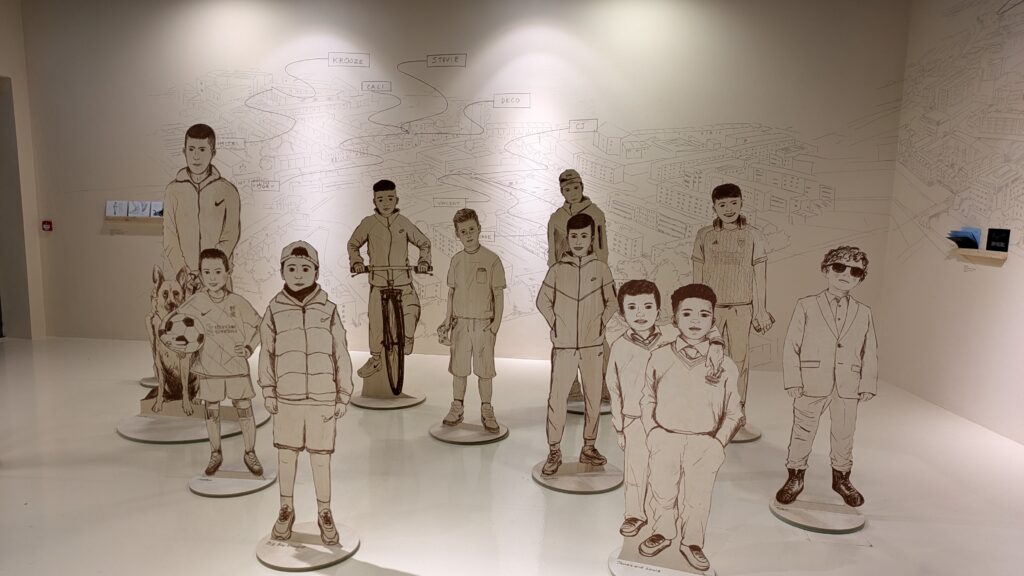[Image – Boys in the Making – Fiona Whelan, Rialto Youth Project and collaborators, NCAD Gallery, 2025]
A personal response to a conference on Boys in the Making, a key program of What Does He Need?, a long-term project exploring how men and boys are shaped by and influence the world they live in.
I am slow. There must be something bovine lurking withing me. I am a cud-chewer. I ruminate and ponder. My thoughts can be slow to come to the surface. Slow to reveal themselves.
Last Friday I sat in a public space, heard a question being asked, and presented myself to answer. But I was unsatisfied with the response I gave. It wasn’t a bad answer, but it wasn’t really what I wanted to say. I knew instinctively that was the case, because I knew my thoughts hadn’t reached the surface yet.
What Does He Need? is a long-term social art program that has at its heart an interrogation of contemporary masculinity in Ireland today, especially masculinity that is subject to inequalities of power, provision, and advantage. It is a project that originated with women, mothers specifically, who were concerned about the world that was shaping and being shaped by their sons. Who would their boys become? What was the world going to make of them? What would their sons make of the world?
Two other women heard these questions and determined to at least try to answer them. Dannielle McKenna of Rialto Youth Project and longtime collaborator, artist and academic Dr. Fiona Whelan of NCAD, along with Feidlim Cannon and Gary Keegan of Brokentalkers theatre company, became the core team that began to formalise the enquiry into the realities, perceptions, and reflections of being young and male in 21st century Ireland.
A public poster campaign that asked and displayed varying answers to the question ‘What Does He Need?’ was the first offer, the first provocation, the first raising of a hand. What came next would shape a template for the rigorous exploration and sharing of life internal and external as experienced by specific groups of boys and young men in their own environment, in their own time, in their own lives.
The boys and young men would take part in a private dialogical process with an artist and youth workers and/or educators and create a fictional boy (or boys) through whom they could explore their experience and lived reality of being a boy. The starting point involved three simple conditions:
He is a boy.
He is from here.
We are responsible for him.
In 2020, this branch of the project produced a public artwork called ‘Stevie’, a powerful animated short built around a poem devised and written by young men in Rialto Youth Project in collaboration with Fiona Whelan and youth workers Michael Byrne and Thomas Dolan. ‘Stevie’ bristles with anguish, yearning, vulnerability, conflict, and fatalism. It demands attention and defies the bestowal of easy platitudes. It shows a masculinity that is not easy to embrace. In its ability to disturb and confront, it leaves the original questions unanswered, but arguably more urgent.
The process that produced ‘Stevie’ became known as Boys in the Making and it was formalised in a repeatable methodology that has now seen the creation of 26 different boys across Dublin. When the methodology was first presented publicly in Rialto Youth Project in late 2021, I was in attendance in my capacity as a facilitating artist who had just begun working on the program with a youth project in Ballymun.
Since that time, I have been involved in the creation of two different boys, and have also performed in 2023’s Manifest, the Brokentalkers production that presents an interpretation of the methodology if it were to be wielded by a bad faith facilitator. I am soon to commence working on another boy with partners who have embedded the Boys in the Making program as a staple of their curriculum.
My ongoing involvement in these different iterations of the work has given me opportunity to be present and speak at subsequent public forums where the What Does He Need? project raises further awareness, gives status updates, shares the insights and expertise of new and existing partners, and invites dialogue from stakeholders in youth work, community outreach, education, civic office and the arts.
Friday of last week, St. Valentine’s Day, saw the most recent of these events, and it came on the final day of a month-long exhibition in NCAD of all the boys that have to date been created by the Boys in the Making program. It was day-long sharing of experience and perspectives of those of us who have worked directly or adjacently with What Does He Need? at varying junctures in the project’s history.
I sat on a panel with artist Aaron Sunderland Carey and RYP youth workers Mick and Sue to discuss our experiences of working with young people on the program; Dannielle and Fiona shared a panel with Kate and Patrick from Heart of Glass, a youth arts organisation in St. Helens, UK to discuss cross-jurisdictional collaboration; Dr. Rob Grant of Trinity College presented a synopsis of the Philosophy with Men branch of the project; Dr. Ernesto Vasquez Del Aguila from UCD presented the dominant areas of enquiry around masculinity from a gender studies perspective; Aaron shared drawings he had made in response to philosophy sessions that had taken place during the exhibition in which he had been a note-taker; and finally Feidlim Cannon and Sean, a young man who had co-created the boy ‘Joey’, did a performance piece that captured something of the essence of the Boys in the Making process.
It had been a full morning, and the venue buzzed with conversation and energy as all in attendance availed of sustenance, vape breaks, message checks, and the opportunity to ask follow-up questions and offer responses to those who had spoken and presented. After lunch, we gathered in the exhibition space for the concluding part of the day – an open forum to facilitate a broadening of the discussion.
Days like this can have a phototropic quality to them – everyone to some extent is leaning towards the light. The room was full of the converted and the curious, the invested and the interested, the collaborative and the cooperative. It is a heady energy, informed by the unspoken understanding that if you are there, you are participating in something akin to an alliance. Even something, as the late Ailbhe Murphy said of it, that might be described as a movement. If you are there, it is because you have chosen to put yourself in that space. Because you have an inkling that this thing is not merely worthwhile, not merely interesting and impressive, but that it is actively, substantively good.
One of the first to speak was Jim Lawlor, a lifelong youth worker and social activist, and another key player in the What Does He Need? family. Momentarily overcome with emotion as the significance of the gathering struck him, he declared himself to be an anti-capitalist, making clear that this was the very best place to start with such work. His assertion came with a palpable mix of humour, passion, and seriousness, and his gently anarchic tone was a reminder that the seeking of change needs something gritty and resistant in it.
As I reflected on the anti-capitalist idea, it seemed more and more perfect in relation to the work that had brought us all together. Capitalism wants things that are easy to commodify, easy to explain, easy to sell, easy to produce, and easy to replace. It despises things that are knotty, unwieldy, and ambiguous. It despises things that take time. Most of all it despises things that threaten the bottom line. And what is more threatening to the bottom line than a consumer who no longer wants to buy what is being sold? A consumer who no longer conforms to type?
In this regard, What Does He Need? implies another, equally pertinent question – what doesn’t he need? Systems of oppression and disenfranchisement, perhaps. Assumptions, prejudice and complacency, maybe. Crude tools and metrics that dehumanise and delegitimise, possibly.
The qualitative approach of What Does He Need? starts with listening. Deep listening. Non-judgemental listening. Listening that eventually responds.
The question that I failed to respond to satisfactorily came from a genuine concern about the bigotry and hatred and radicalisation that conspire to contort the minds and souls of young men who theoretically could end up participating in the Boys in the Making program. The question essentially was ‘What then?’
I echoed something Rob Grant had said about providing the right mood for dialogue. If the space is a non-judgemental one, I argued, all ideas and sentiments can be looked at openly in the spirit of good faith examination. In an imperfect and non-dogmatic practice, it was a pretty good place to start. My answer was reiterated by others with improved complexity and nuance and met with general approval, but it got away from a more fundamental truth that may have better served the question in the first place.
What are the conditions and convictions that might contribute to young male anger? What might inform and fuel the aforementioned bigotry, hatred and radicalisation? Setting aside for a moment the world of bad faith manosphere influencers and the macro lens that might address generational socio-economic disadvantage and cultural and institutional rejection, let’s just focus on what many young men potentially believe about themselves.
That they are unloved.
That they are uncared for.
That they are unvalued.
That they are unheard.
That they are unseen.
I had those beliefs about myself as an adolescent, but I wasn’t able to articulate them. And it left me confused and hurting. It never occurred to me to direct my anger at anyone other than myself. And that idea implanted itself so persuasively in my being, that I have co-existed with a suicidal impulse for the last thirty-six years.
But I was lucky. Because something in me grasped for relationships that would nourish and sustain me. My interest in and love for my friends and partners outweighed my frequent abandonment of myself. Those relationships gave me the love, care and value that I craved. In those relationships I was heard. And because I was heard, I was seen.
The boys and young men who engage with the Boys in the Making program are listened to. And that means they are heard. And that means they are seen. And when you can be seen, it is much easier to be held. And when you are held, you know you are cared for.
In March of last year, I was part of the What Does He Need? team that travelled at the invitation of Heart of Glass to present the methodology to an assembly of stakeholders from St Helens. Last Friday, Patrick Fox was curious to hear our impressions from that event. I had one simple takeaway: everyone who was there that day had been there for one reason. They care about men. They care about boys. And they want to find a way to show that care.
That demonstration of care, and the implication of being held, do not amount to a silver bullet that will prevent young men becoming wolves, but they at least indicate a path where the woods are not quite so dark and deep.
For more information, please visit https://www.whatdoesheneed.com/



